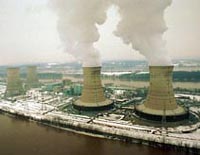California lab meltdown in 1959 may have caused cancer, hurt ground and water
A 1959 nuclear reactor meltdown at the Santa Susana Field Laboratory may have caused hundreds of cases of cancer in the community, and chemicals threaten to contaminate ground and water, according to a report.

The report released Thursday by an independent advisory panel estimated it was likely that radiation released during the meltdown caused about 260 cases of cancer within a 60-square-mile (154-square-kilometer) area around the reactor.
The lab's former owner, Rocketdyne, has said for years that no significant radiation was released. But the independent advisory panel said the incident released nearly 459 times more radiation than a similar one at Pennsylvania's Three Mile Island in 1979.
"People have been asking for 20 years what was the impact of the meltdown, and now they will at least have an approximation of how many people may have been hurt," said Dan Hirsch, co-chairman of the Santa Susana Field Laboratory Advisory Panel.
The panel of experts from around the country was formed by legislators in the early 1990s who responded to residents' calls for independent health studies of the site.
The 4.5-square-mile (11.5-square-kilometer) site about 30 miles (50 kilometers) northwest of downtown Los Angeles was used for nuclear research for four decades beginning in the 1940s. Rocket engines also were tested there.
A Rocketdyne spokesman said the company, now known as Pratt & Whitney Rocketdyne, no longer owns the lab site and referred questions to the current owner, Boeing Co.
Blythe Jameson, spokeswoman for Boeing, disputed that there was a threat, calling the site safe.
The Energy Department, Boeing and the state have been involved in efforts to decontaminate the site. The state has estimated that more than 1.73 million gallons (6.55 million liters)of toxic trichloroethylene was dumped on the grounds and that 500,000 gallons (1.9 million liters) have saturated the bedrock beneath the lab.
The panel concluded local soil and groundwater also may have been contaminated. The rocket fuel additive perchlorate has been found in a well, but Boeing has disputed assertions it came from the lab. Long-term exposure to high levels of perchlorate can cause thyroid problems, reports AP.
In 1999, the federal Agencies for Toxic Substances and Disease Registry concluded people in the area were not being exposed to levels of chemicals or radiation that impact their health, and three other studies failed to find any evidence of increased cancer rates, Jameson said.
Boeing, however, agreed last year to pay $30 million to settle a lawsuit alleging that pollutants from the site caused nearby residents to get cancer.
Subscribe to Pravda.Ru Telegram channel, Facebook, RSS!




